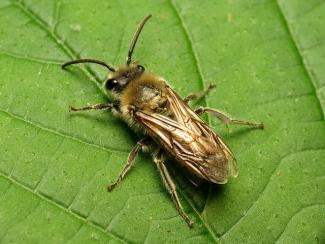
Image Credit: Katja Schulz
Silk (or cellophane)-lining Bees (Colletidae: Colletes)
Bees in this subfamily are easily recognized by the S-shaped form of the 2nd recurrent vein in the forewing and the distinctly tapering (wasplike) form of the abdomen. All members of this family line most of their main burrows and cells with a transparent film; their pollen supplies in the cells are mixed with so much nectar that they appear like a type of soup. This same burrow lining behavior is found in the pemphredonine aphid-wasps, which are generally accepted as the ancestors of all bees. Most Colletes bees are conspicuously hairy, with hairy transverse abdominal bands, and have black faces. There are approximately 100 species in the USA; and, they are found in all environments
Species of Colletes include both generalists and specialists; they are difficult to distinguish in general without dissection of their genitalia. The most notable species, to my mind, is Colletes kincaidii a very widespread western species which frequents many flower species throughout its range. In the vicinity of Santa Cruz, California, it is restricted to feeding on the pollen of the wind-pollinated tan-oak, it nectars widely but most frequently on yerba santa (Eriodictyon). This species nests in an immense aggregation of many thousands of nests excavated through cemented case-hardened limestone. (They also nest through the cement mortar in the brick walls of nearby houses!) After decades of use the cemented exterior of the limestone breaks off and falls to the bottom of the cliffs, where it builds up to depths of many meters, evidence of hundreds/thousands of years of continual usage! Though male bees compete aggressively with one another during the daytime, aggregations of 1-2 dozen male Colletes kincaidii are commonly observed in the vicinity of Oregon State University sleeping in huddled masses on 1-year old fruiting stalks of Queen Anne’s lace (Daucus carota).


These pictures are typical of most of the species in this group in North America, though the reddish hair does make it special. In a dorsal view the abdomen would appear to taper from the basal tergum evenly towards the rear. In the PNW we have a melanic species which is a specialist in the high mountains on blue-bells (Mertensia). The males of many species of bees are vicious competitors for mates during the day, but often roost communally for the night on the same protruding piece of vegetation.